Compressed Air Massage
In 1954, Jacques Courtin [1921-2007] opened his Centre de Traitement Clarins at 35 Rue Tronchet, Paris. The following year he applied for a patent – granted in 1957 – for a pneumatic massage machine inspired by newsreel images he saw of a test pilot in an open cockpit.
One day at the movies, a scene in the newsreel gives Jacques Courtin an idea.
“There was this test pilot flying in an open cockpit. His face was obviously exposed to the outside air and you could see his skin rippling with the force of the wind.”
Jacques Courtin recognizes the effect. It is exactly what happens with a properly executed Wetterwald maneuver massage—the skin “flutters,” just like a slack sail on a boat. The waves of air neither pinched the pilot’s skin nor wrinkled it, neither pulled at nor distended it. They did not seem to hurt it in any way. In fact they appeared to act like a form of treatment.
In a flash Jacques Courtin realizes the great benefits to the human body of harnessing the power of air.(Courtin, 2006, pp. 54-55) The ‘Wetterwald maneuver’ is a massage movement created by Félix Wetterwald [1869-1935] in which the skin is pinched and rolled using the thumbs and fingers of both hands.
The newsreel that inspired Coutin may have been similar to the one below of a volunteer subjected to a wind speed of up to 457 mph captured by the American National Advisory Committee for Aeronautics (NACA) in 1946.

Above: 1946 Volunteer at NACA (Langley Research Center).
To put his treatment idea into effect, Coutin needed a source of compressed air. Fortunately, one was readily at hand – the Paris pneumatic system.
Paris pneumatic system
Paris, like many other major cities in the days before fax and email, had an extensive system of pneumatic pipes running through the underground passages originally created to house the city’s sewerage system.

Above: Underground tubes of the Paris pneumatic system. The tubes ran through the vaulted sewers built by Georges-Eugène Haussmann [1809-1891] during the renovation of Paris between 1853 and 1870.
In 1955, the year Coutin submitted his patent, the Paris pneumatic system was the largest in the world. It had over 450 kilometers of piping and processed more than 11 million documents annually.
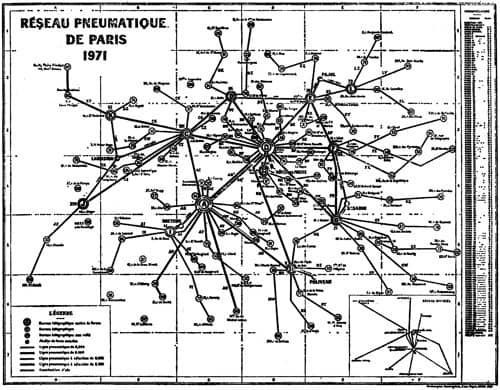
Above: 1971 Map of the Paris pneumatic system.
The Paris system was managed by the Société Urbaine d’Air Comprimé (SUDAC). Once Coutin obtained permission to use the SUDAC compressed air network he set about designing and building a regulating mechanism and nozzles to deliver the compressed air.
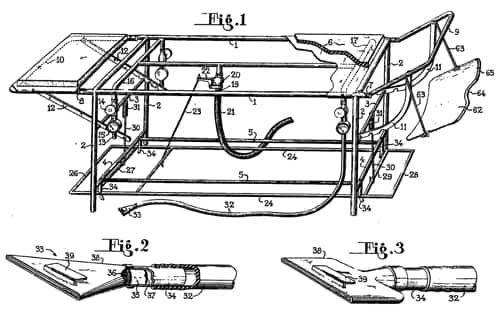
Above: 1957 Jacques Courtin’s designs for a table with hose connection to the Paris pneumatic system (Fig. 1) and for two nozzles (Fig. 2 and Fig. 3) (French patent: FR1138679A, 1957).
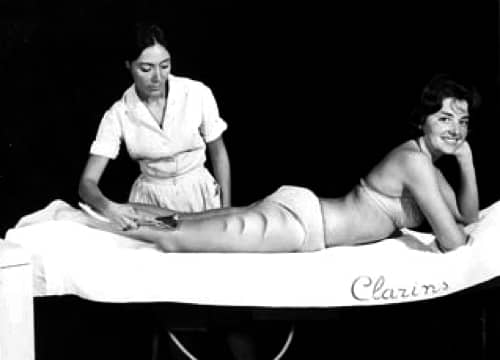
Above: Clarins compressed air massage.
Coutin was not the first person to use the Paris pneumatic system in a beauty treatment. In the 1920s, compressed air from the system had been used to cool the heads of customers undergoing permanent wave treatments.
Edna Kent Forbes of Paris tells, in one of her “Beauty Chats,” how compressed air is being used to lessen the discomforts of ladies undergoing the painful process of the “permanent artificial hair wave” at the hands of the Parisian beauty experts. …
It is a tropical experience for the patient, for a great deal of heat is generated in the spools. The whole apparatus looks like some device of the Spanish Inquisition. This is where the compressed air comes in, for the operator stands beside the victim and blows a current of air from a rubber hose over the scalp to alleviate the suffering. Every beauty parlor or barber shop in Paris may have compressed air at its command, for it is piped through the streets just as gas and water are in other cities.(Compressed air magazine, 1921, p. 10019)
Coutin initially referred to his treatment as aerovibrothérapie and recommended it for cellulite and body contouring. Its introduction saw similar devices appear in other Parisian salons. I suspect that on the whole these treatments – advertised under names such as Aéromassothérapie, Pressozone, Soufflothermie, Aéro-Compresso-Réducteur and Compressothérapie – were copies of Coutin’s idea rather than licensed from Clarins.
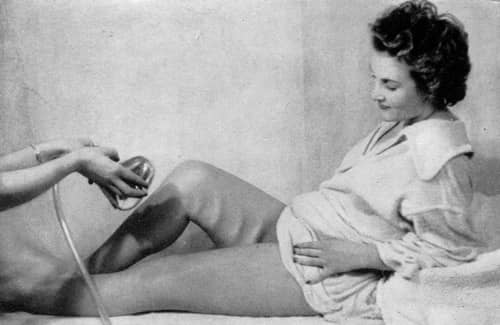
Above: 1957 Jeanne Piaubert Aéro-Compresso-Réducteur Treatment.
Air Rythmé
Jacques Coutin’s aerovibrothérapie was restricted to places where a pneumatic system was in operation. This meant that it was largely unavailable outside of Paris.
The Clarins center is doing very well, its new techniques revolutionizing beauty treatment. It is so successful that its reputation spreads to physical therapists throughout the country. They ask Jacques Courtin if they can use his compressed air method. However, as Paris is the only city in France with an underground air system, he must continuously turn them away.
(Courtin, 2006, p. 63)
To promote the treatment more widely, Coutin developed and patented a compressor (French patents: FR1180023A, 1959; FR1172650A, 1959) which allowed the treatment to be offered anywhere.
In Levallois, a Paris suburb, Pierre Vernhes [an intern at Clarins] locates a factory that makes a rotary compressed air machine. Perfect—no piston means virtually no noise or vibration. The contraption can be regulated to produce a steady stream of air at the desired level of pressure. Weighing in at almost half a ton, it has obviously been designed for industrial purpose but Pierre Vernhes doesn’t care—he’s good with his hands and very imaginative. After a few adjustments the machine is ready for use in Jacques Courtin’s massotherapy technique. The patent is registered with the name aerovibrothérapie.
(Courtin, 2006, p. 64)
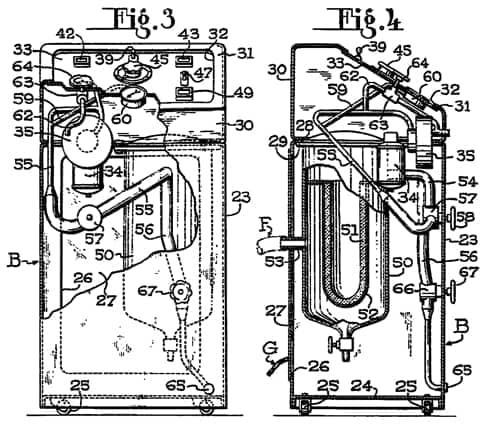
Above: Jacques Courtin’s design for an air compressor (French patent: FR1180023A, 1959).
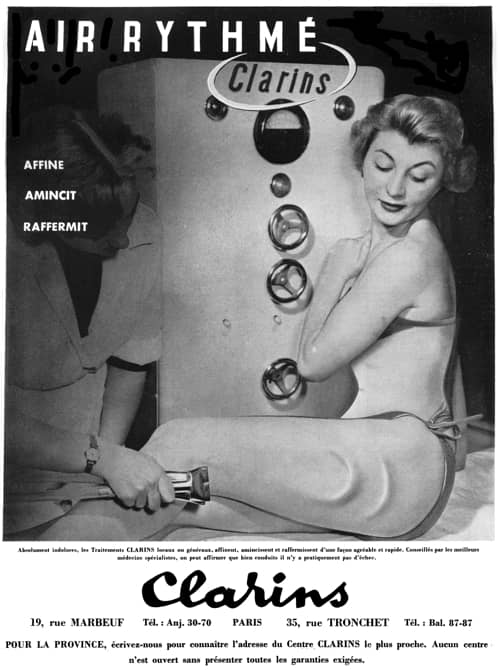
Above: 1958 Clarins Air Rythmé compressor.
Compressed air massage treatments appear to have been largely restricted to French beauty houses in late 1950s and early 1960s. Clarins was still offering a similar treatment in Paris in the late 1970s by which time it was known as Drainothérapie. Despite Coutin’s description of it being relatively noiseless and comfortable the reality seems to have been otherwise.
Drainothérapie … is a rhythmic air massage developed and performed at Clarins. Clarins claims that one drainothérapie session is as effective as sixty manual massages. They could be right. For this treatment, you must hold a plastic shield in front of your face and wear earplugs, so powerful and noisy is the vacuum cleanerlike [sic] apparatus.
For forty minutes your cellulite is pummeled with a mighty current of air, strong enough to lift your leg up by itself. Your skin literally ripples and waves under its force. Drainothérapie is not pleasant, as massage is. Rather, it is in the realm of discomfort, but not quite at the threshold of pain.(Dannenberg, 1979, pp. 117-118)
Updated: 28th March 2018
Sources
Arlinghaus, S. L. (1985). Down the mail tubes: The pressured postal era, 1853-1984. Institute of Mathematical Geography. Michigan: Michigan document Service.
Compressed Air Magazine. (1921). 21(1), January.
Courtin, J. (2006). A beautiful success: The fabulous adventure of Clarins (S. L. Segall, Trans.). Clarins SA.
Dannenberg, L. (1979). The Paris way of beauty. New York: Simon and Schuster.
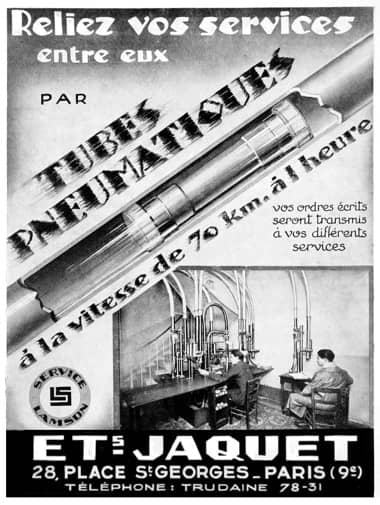
1930 Jaquet pneumatic tube service, Paris.
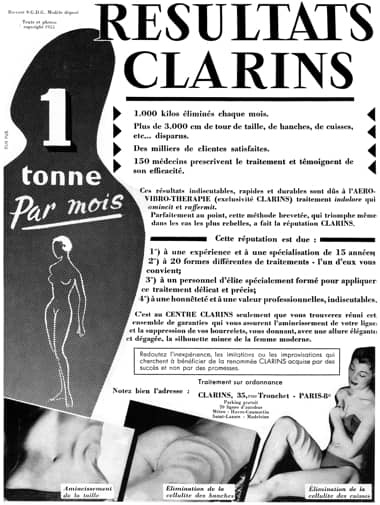
1956 Clarins aerovibrothérapie for the elimination of cellulite.
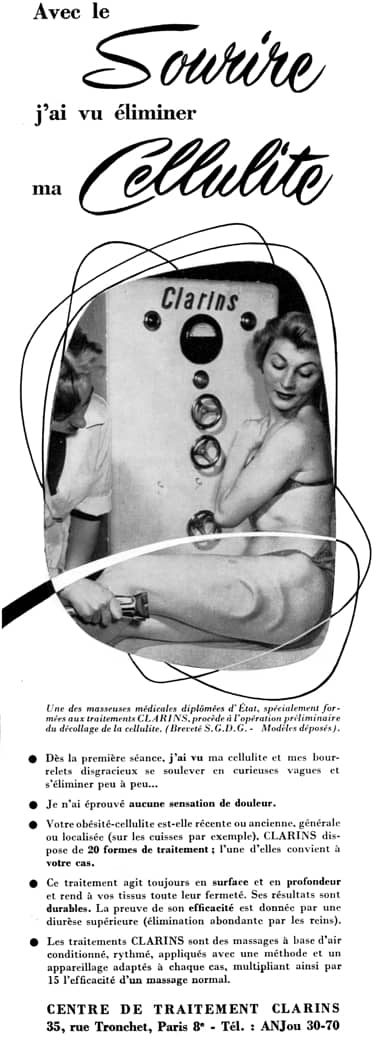
1956 Clarins cellulite treatment.

1956 Sabor Aéromassothérapie Climatisée.
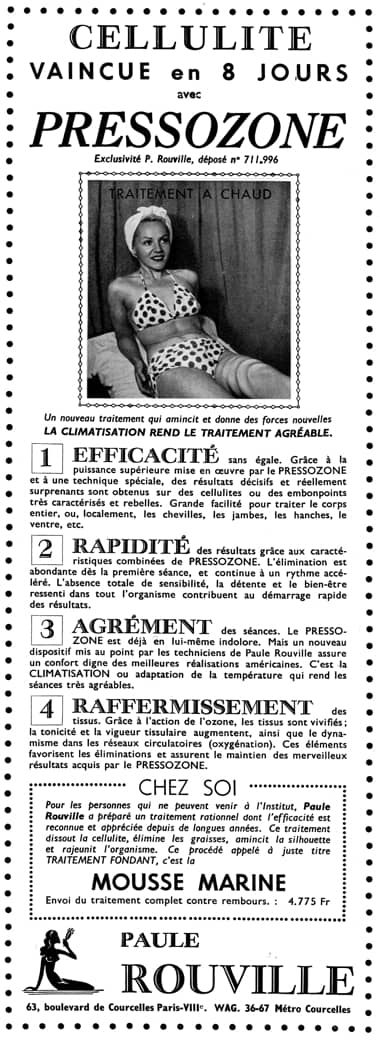
1956 Paule Rouville Pressozone.
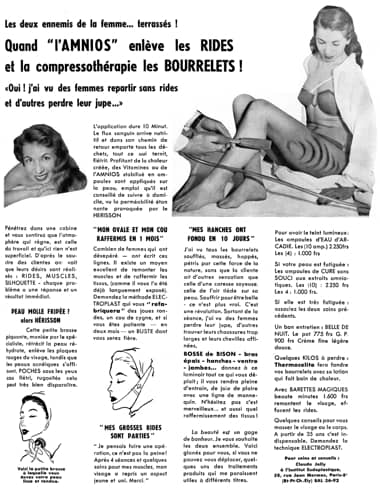
1956 Endoplastique Compressothérapie.
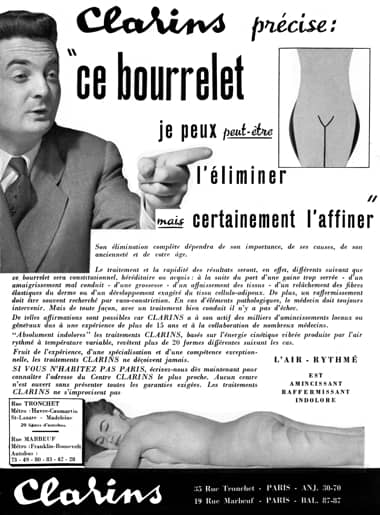
1958 Jacques Courtin promoting his ’Air Rythmé for ‘refining’ body fat.

1958 Yvonne Thuault Soufflothermie.
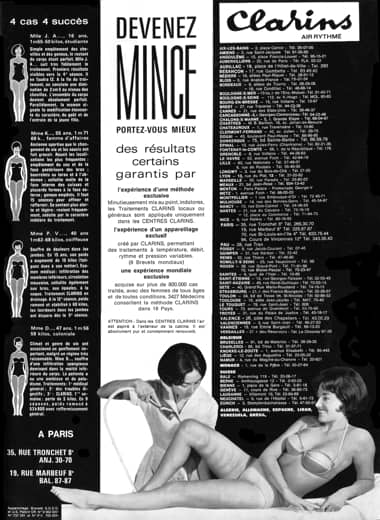
1965 Clarins Air Rythmé.
